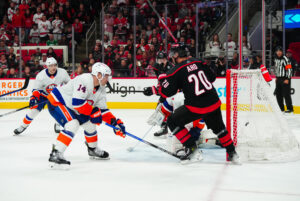It’s no secret that the Carolina Hurricanes have been the kryptonite to the Boston Bruins during the 2021-22 campaign. Going into Game 3, the Bruins had not figured out a way to beat this young, fast Hurricanes team. After dropping the first two games by a combined score of 10-3, Boston returned home with one question to answer: how on earth do we beat these guys? With the weight of the world on their shoulders, the Bruins were able to grab a win and make the series 2-1 going into Game 4.
Current Trends in the Hurricanes vs Bruins Series
This series has epitomized the term “home-ice advantage” for both squads so far. The Carolina Hurricanes were dominant in Games 1 and 2 at home, led by the elite play of Sebastian Aho and Nino Niederreiter on offence and Jaccob Slavin on defence. The Canes made the Bruins look lost on the ice and dictated the pace of play from start to finish. A major series-influencing statement was made in Game 2 when forward Andrei Svechnikov levelled Bruins defender Hampus Lindholm on a clean hit. Despite getting embarrassed on the road, Boston’s comeback in Game 3 shows that the veteran squad isn’t out quite yet. The first three games of this series have shown that several key factors will ultimately determine who moves on and who goes home.
Special Teams
In our series preview, we outlined how special teams would be a major factor in this series. The Hurricanes have the most formidable penalty kill in the league, while the Bruins are one of the best powerplays thanks to the “perfection line.” More penalties are being called in this playoffs than in years past, meaning special teams opportunities are more abundant. Carolina capitalized on Boston’s lack of discipline in Game 2 and scored two back-breaking powerplay goals to pull away from the Bruins in the second period. On the penalty kill side, they were able to limit the Bruins to one powerplay goal over seven total chances in the first two games of the series. However, the Bruins knew that that had to change when the series shifted to Boston.
In Game 3, the Bruins got the band back together and scored three special-teams goals (two on the powerplay, one short-handed) in their winning effort. Thus far, both teams have found wins in games where their special teams units have played well. Given the increase in penalty calls these playoffs as opposed to years past, each game could be decided by which team can draw more penalties and give their powerplay more opportunities to cash in on the opponent’s mistakes.
Embed from Getty Images
Diverse Goal Scorers
For the first two games of this series, the Bruins’ offence was almost entirely driven by one man: Patrice Bergeron. Knowing that Bergeron was the only Bruin with a hot stick made life easy for the Hurricanes. Being able to focus on one player (or line) has made the game more one-dimensional for Carolina. Carolina, meanwhile, has benefitted from having eight unique goal-scorers thus far in this series.
This kind of depth scoring that the Hurricanes are showcasing is usually a recipe for success in the playoffs. Teams cannot be reliant upon one or two lines to deliver offensive chances when teams are so evenly matched. If the Hurricanes can continue to limit Boston’s bottom-six forward group while maintaining their own depth scoring, this series will not continue for much longer.
Persistent Goaltending Questions
One thing both squads have in common is persistent questions over who’s manning the net. These questions are set to continue for the remainder of the series. For Carolina, the health of Frederik Andersen and Antti Raanta has forced 22-year-old Pyotr Kochetkov to man the crease. Despite success in Game 2, Kochetkov was enveloped by the Bruins’ offence in Game 3 and allowed four goals. Andersen, Carolina’s preferred starter, looks to be out until at least the second round (if the Hurricanes qualify).
On the other side, Boston seems to have finally made a decision on who their number one goaltender will be for this postseason. After Linus Ullmark allowed ten goals in Games 1 and 2, the Bruins turned to Jeremy Swayman, who put up a .926 save percentage in a winning effort in Game 3. Both goalies are inexperienced in playoff hockey, but Swayman’s steady hand in Game 3 was a calming presence in what had been an erratic crease under Ullmark.
The first three games of this series have seen goaltending, special teams, and offensive scoring depth play a major role in the outcome of each game. There are no signs of that changing heading into Game 4.
Main Photo:
Embed from Getty Images






